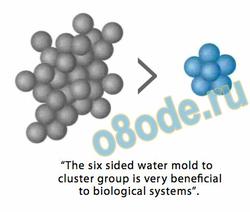 Water Clusters — Ultra Hydration for Metabolic Efficiency
Water Clusters — Ultra Hydration for Metabolic Efficiency
Water Clusters — Ultra Hydration for Metabolic Efficiency
In the last decade we have seen an emergence of a several new classes of bottled waters. These classes go by the several names: energetic, structured, clustered, electrolytic, and eloptic to name a few. The question that must be answered is, “What do these new classes mean and how can they help us live healthier happier lives?” To understand this we must first examine the basic physics of water. Water on the surface seems fairly simple. Combine 2 hydrogen atoms together with a receptive oxygen atom and you form the basic H2O molecule. In nature, these H2O molecules form complex patterns by grouping and clumping together into “clusters”. These clusters form around ions in the solution, and are in and ever changing state of flux. They expand and contract continuously, grouping into large clusters and then splitting apart into smaller ones. This flux or change in clusters is called the Brownian movement of water.
Large clusters are harder to absorb into biological systems. The body must reduce these large clusters into more soluble smaller clusters. It does this by introducing energy to the water to break it down. The process of absorption is called osmosis and by controlling the size of these clusters you can affect the amount of absorption or hydration in biological system. The trick is to find a way to control these clusters.
In examining water we know that it responds systematically to most forms of energy, from kinetic, to stellar radiation. As we apply energy to water the large water cluster groups begin to reduce themselves to smaller groups. We’ve all experienced this phenomenon when we boil water. As we apply the heat energy to the water the osmobility increases. Thus food that would take days to hydrate becomes fully hydrated in a relatively short time. Thus, by adding energy we have broken down the clusters completely. In addition to electrical energy it can be shown that certain wavelengths of light can get water to arrange into controlled cluster sizes. The study of this phenomenum is called photochemistry. Thus, by introducing energy to water you can make it “wetter”.
So how does our body use water? All scientists agree that water plays a primary role in our bodies. The most recent theoretical approach being explored in alternative medical fields is the recognition that the body is a bioelectrical mechanism. For hydration to occur under this model the right ratio of electrolytes need to be present for hydration to occur.
As we age the body progressively loses this ability to hydrate the cells effectively. The cells are unable to produce the extra energy required to break down the clusters, and the cells get dehydrated. This is evident in the fact that newborns are 85% water by weight whereas elderly people get down to 60% water by weight. This means that as we age the biomechanical system inside out bodies is losing its ability to hydrate, and anything that can be done to help it hydrate with less energy would improve the symptoms of aging.
In nature, H2O molecules form complex patterns by grouping and clumping together into “clusters”.
These significant advantages motivate people to attempt to make a water with smaller molecule clusters. Many of the early processes were done with chemical catalysts. Some of the early pioneers in the field were a product called Willard water, and the electrolyzed waters from Russian and Japan. These products applied electrolyzing technology that separated high and low pH water through a membrane. By applying energy to these waters small clusters were formed, however, they were only held for a relatively short period of time. The major challenge has been how to keep these clusters stable after the energy has been removed. If just applying energy to water would keep the molecule clusters small then we would just have to boil our water and wait for it to cool and we would live longer healthier happier lives. Unfortunately, as soon as the energy fields are removed, water will immediately regroup into large cluster clumps. To combat this, there are certain mineral ions that help cage some of these smaller molecule clusters. Some waters in the market have achieved great commercial success even though they maintain a relatively small number of small clusters in the product.
 There are five places in the world where high up in the mountains living Springs coalesce with glacier waters to make the supercharged water.
There are five places in the world where high up in the mountains living Springs coalesce with glacier waters to make the supercharged water.
Residents who drink this water are living healthy productive lives in their hundreds. Attempts have been мейд to remove and bottled this water but once the water is removed from the source the energy is rapidly depleted and the results diminish.
The approach of Phase Angle Labs, is a revolutionary approach to this problem. What we have done is create a means to allow water to hold onto the energy applied to it. This energy remains in the water once it is bottled, and more importantly, when the water is consumed. By realizing this, we can control the water molecule cluster size and thus the waters osmobility. By doing this we will allow people to actually feel and measure the waters energy, and take control of their hydration.
“The six sided water mold to cluster group is very beneficial to biological systems”.